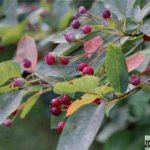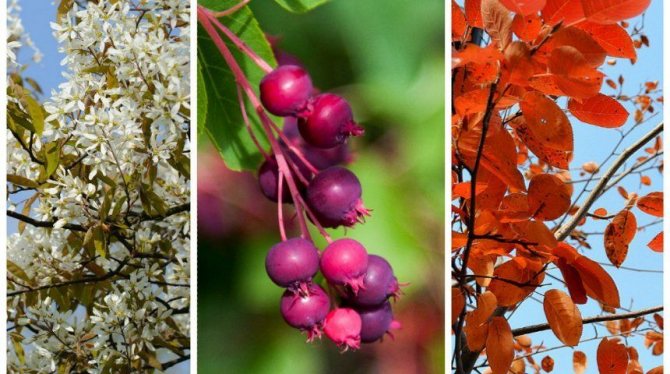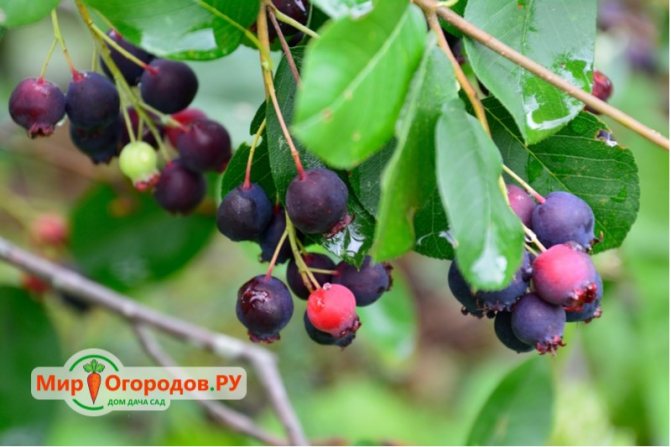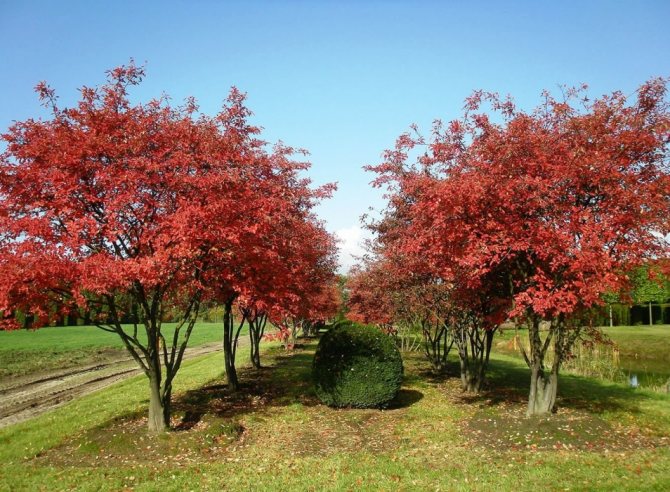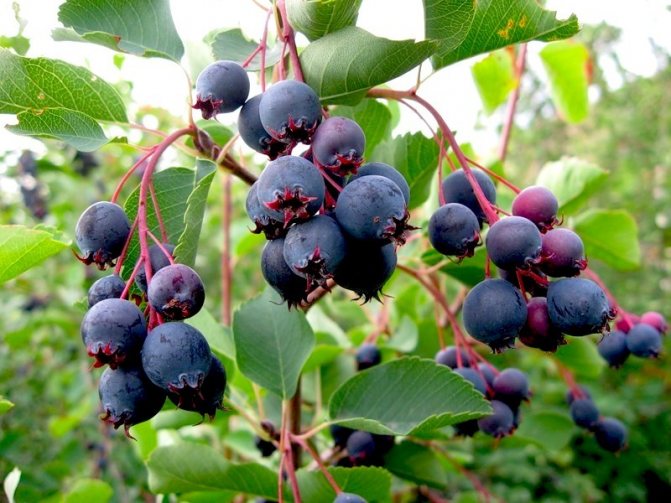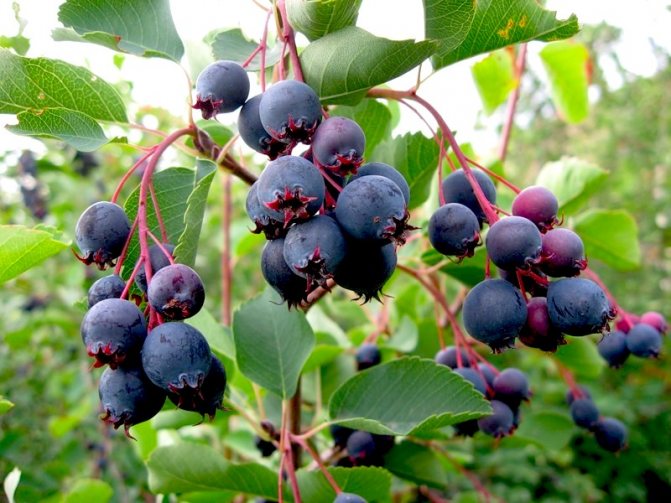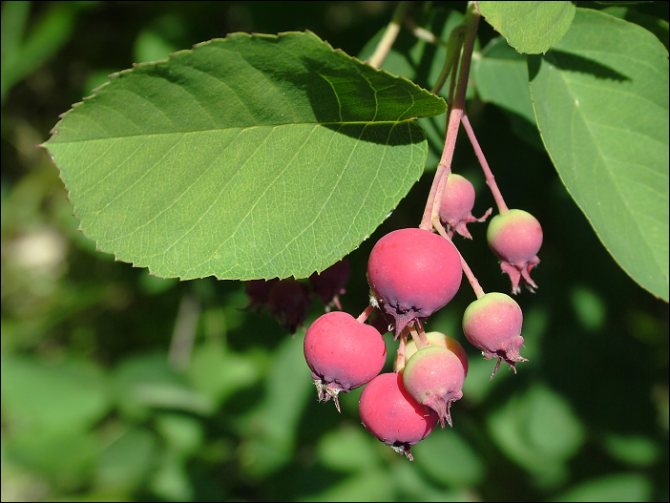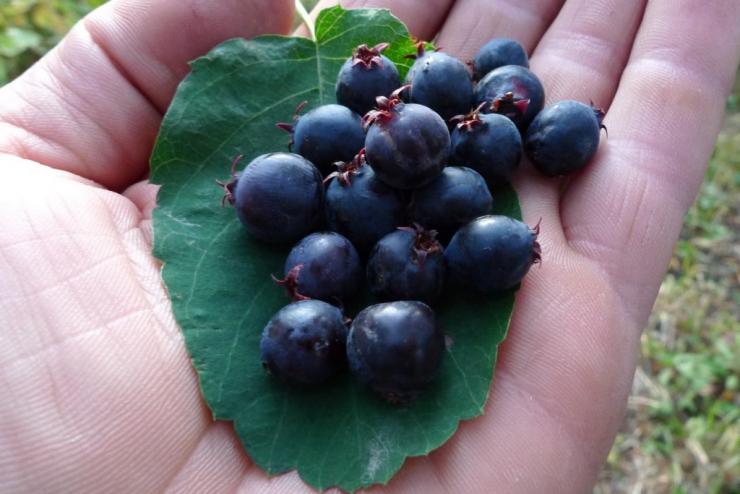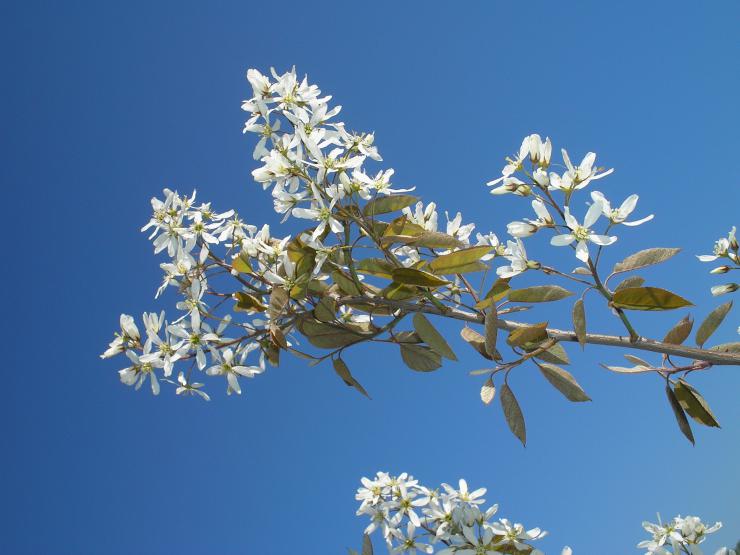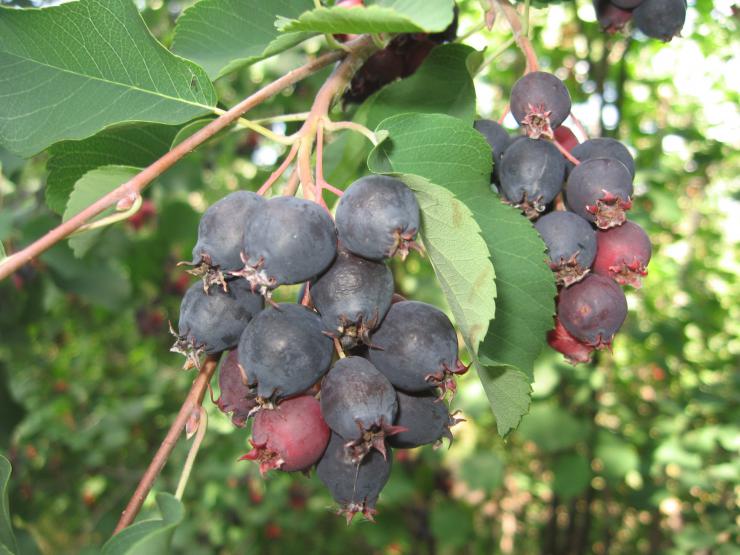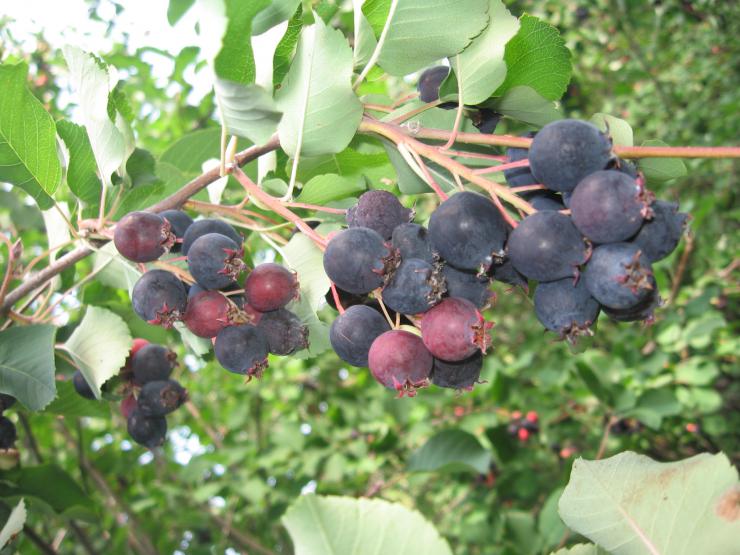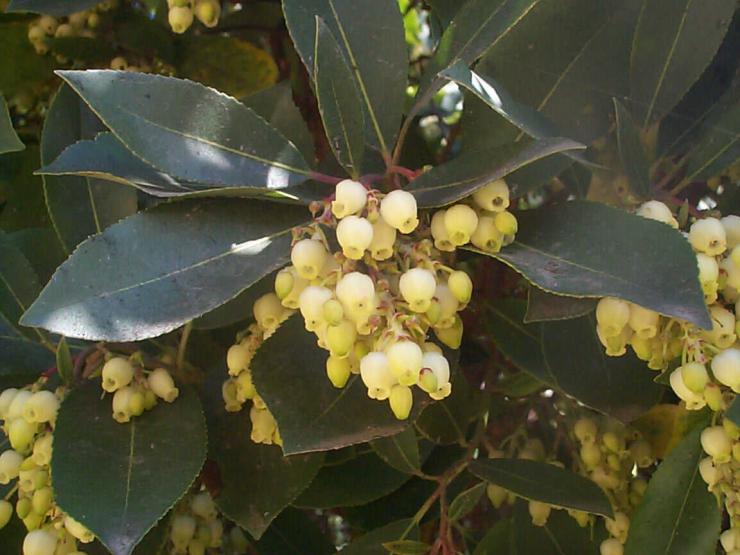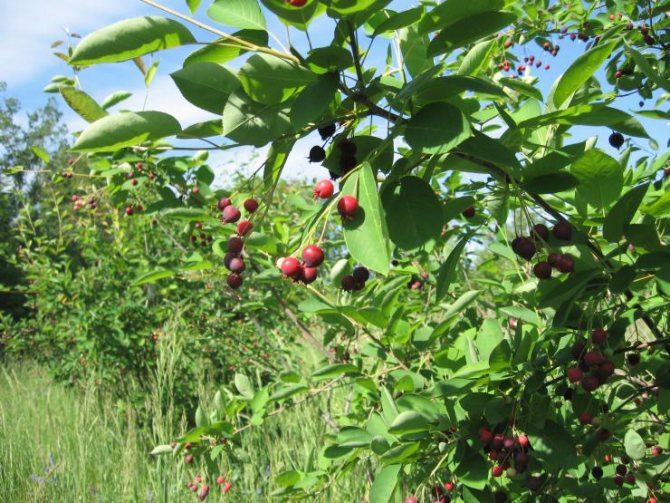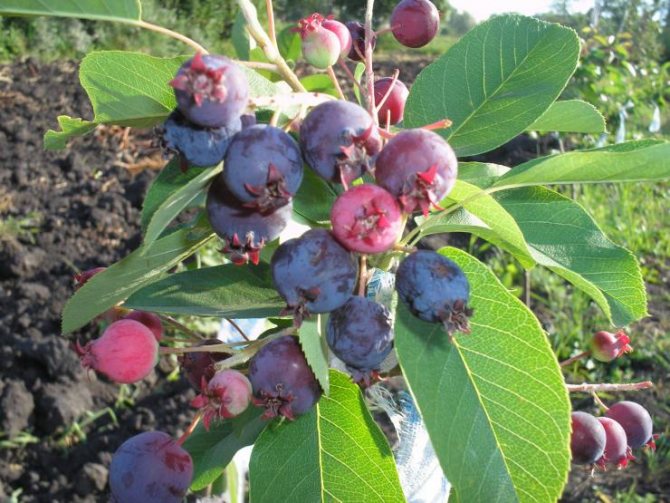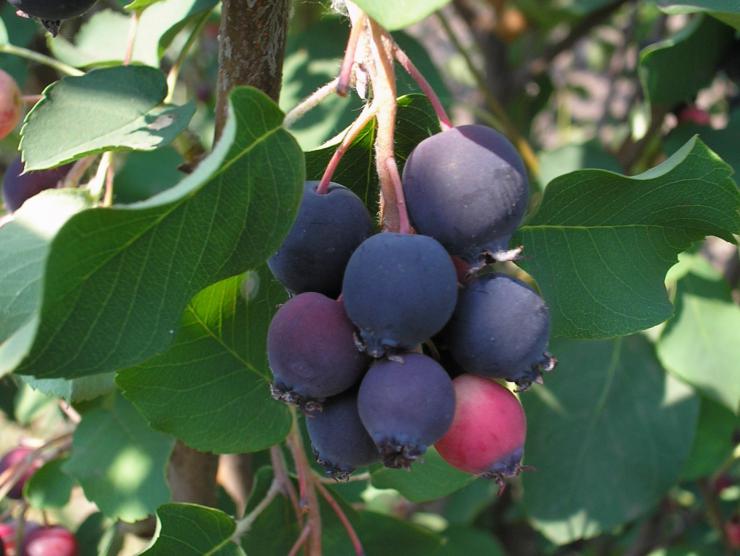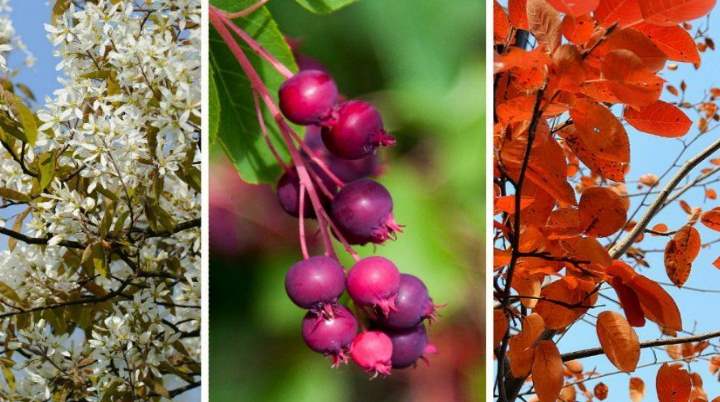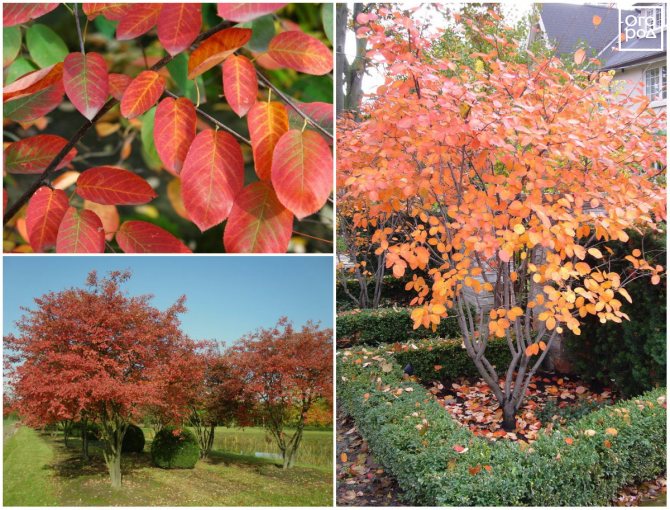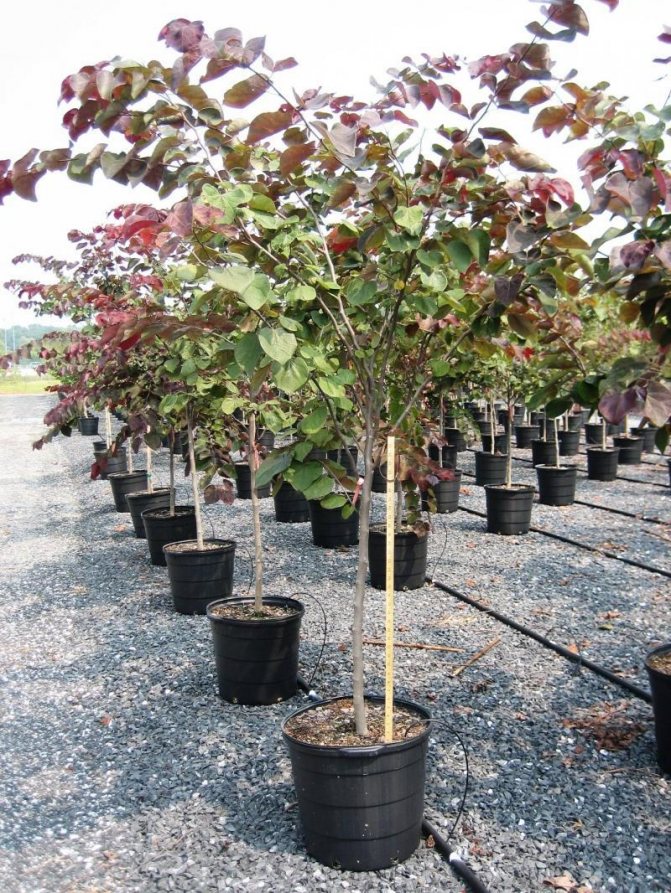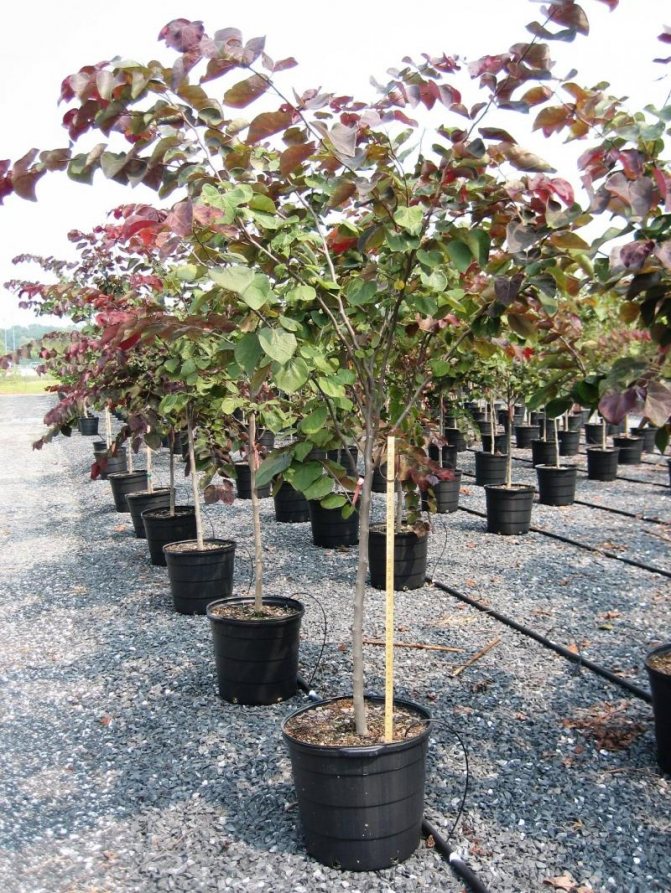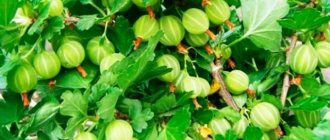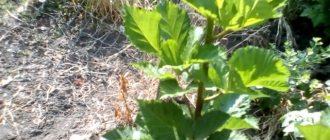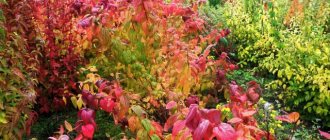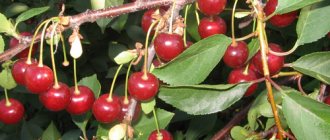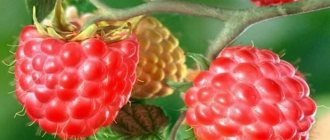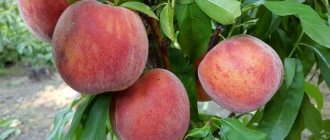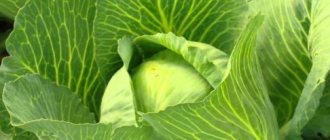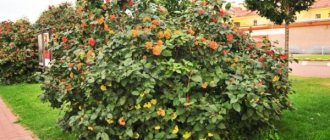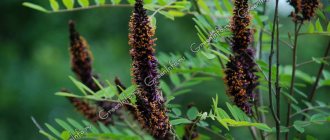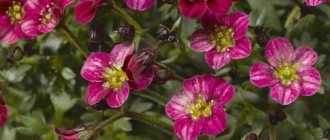Irga Lamarca - this plant is highly recommended for planting in personal plots and gardens, due to its high frost resistance and low soil requirements. In spring it is adorned with beautiful flowers, and in autumn, the beautifully exquisite color of the leaves. Also attractive are the fruits of irgi, a bit reminiscent of American blueberries. Learn the secrets of growing irgi and how to plant it on the site.
Description
It is a tall, deciduous, tree-like shrub. Belongs to the Pink family. Natural habitat - North America. It grows on forest edges, roadsides and in the mountains. The shrub is doing well in the Caucasus and Crimea.
Important!
Irge has a temperate climate. The plant is winter hardy.
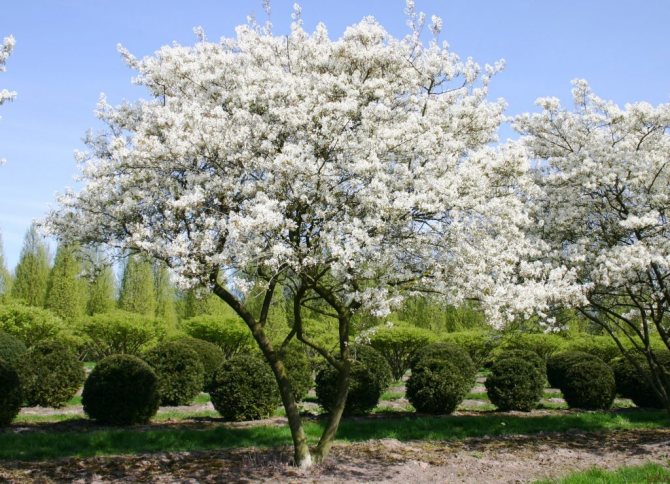
Irga Canadian has been living for 50 years. Berries appear on the bush within 4 years after planting in open ground. About 20 kg of fruit can be removed from one yrgi per year. At 10 years old, the plant is considered fully mature.
Young shoots are covered with reddish bark. The spreading crown is close to the shape of an ellipse. Green leaves have a slight roughness both on the outside and on the inside. Roughness is created by a slight gray pubescence. In autumn, the foliage changes color to red-crimson shades.
The root system is located in the upper part of the soil, extending only 40-85 cm deep. The roots can spread up to 2-3 m in breadth. Basal growth is actively developing along with the shrub.
Important!
Irga canadensis is very difficult to completely remove from the site, roots and shoots grow in all directions.
The shrub is a honey plant, blooms for at least 14 days. The fruits are presented in the form of dark lilac berries.
Reproduction of irgi canadian
There are several ways to propagate a favorite variety: green cuttings, seeds, division of the root system, layering and shoots.
- 12-15 cm cuttings are cut from the last decade of June to the second decade of July from the tops of 5-6-year-old branches. Rooted in greenhouses, planted in spring;
- Berries for seeds are selected from the most productive bushes, they are allowed to fully ripen. Sow immediately in the fall, covered with foil. If sowing in spring, the seeds are stratified for 80-90 days in the basement, placed in a bag of wet sand;
- Having dug up the plant, the rhizome is divided with a sharp tool and long branches are cut off. Remove old branches and place delenki in new holes;
- In early spring, near the lower healthy 1-2-year-old branches, a groove is dug, where the branch is laid, pinning with garden staples. Cover with earth and watered. Plants develop from the buds;
- In autumn or spring, young shoots are separated from the mother bush.
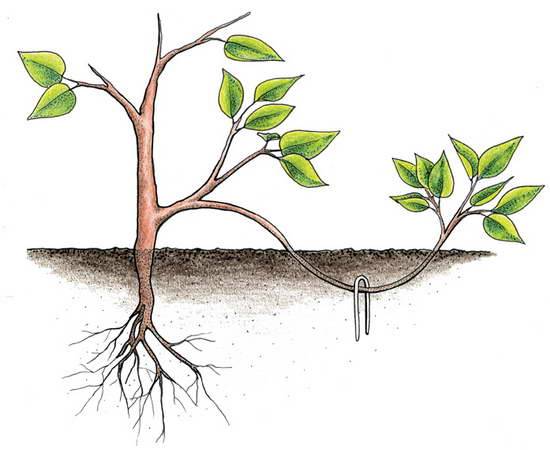

Types and varieties
Various varieties of irgi began to be bred in the 17th century. New varieties with sweeter and larger fruits appear regularly. The most popular varieties among gardeners will be presented below.
Pembina
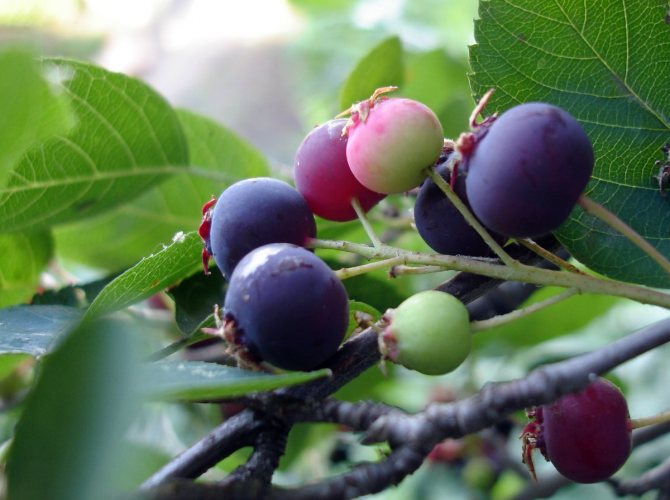

Features:
• fruit diameter 1-1.5 cm;
• the plant bears more than 25 kg of berries;
• ripens by July.
The shrub can reach a height of 4-5 meters. It tolerates frost with a temperature drop below 50 ° C.
The growth of shoots is less than that of other varieties. The berries are sweet in taste and have a slight astringency. Delicious wine is prepared from the fruits.
Thyssen
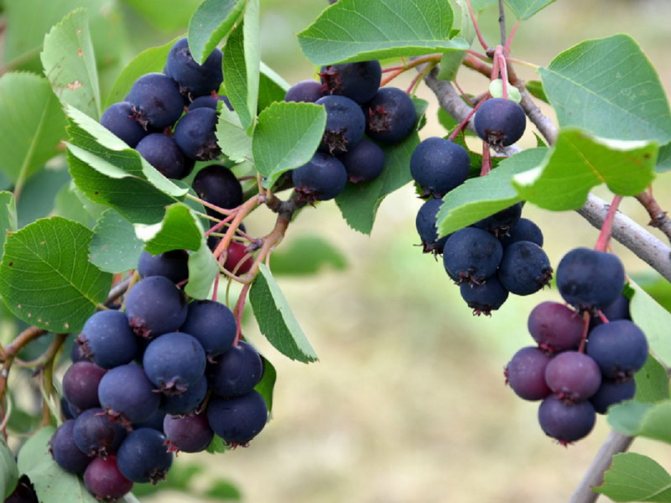

The rounded crown can grow up to 5-6 m. Berries appear 3 years after planting in open ground. The fruits appear in the middle of summer. They are distinguished by their large size compared to other varieties. The diameter of the fruit is at least 2 cm. The shrub bears fruit for 60-70 years.
Important!
Thyssen practically does not get sick, but it must be protected from birds, because birds love to feast on juicy berries.
Smokey
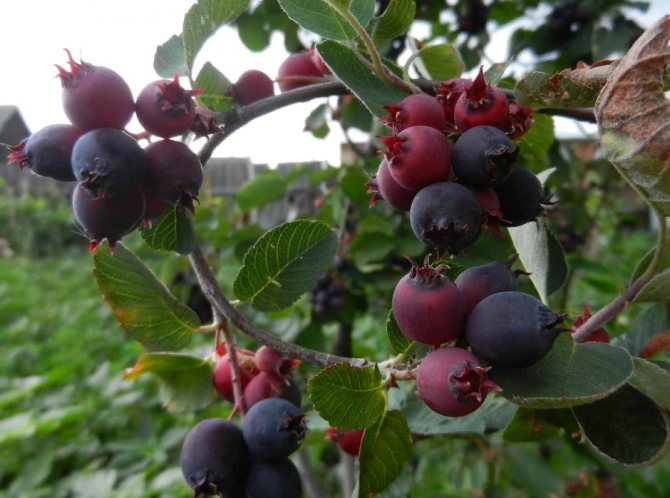

A vigorous shrub is rarely found in the CIS. The fruits appear in the middle of summer. About 8 kg of berries are removed from one plant. The berries are painted in a dark blue shade, on top it is covered with a white waxy bloom. It protects the berries from damage.
Smokey has good immunity. This variety does not like drought, therefore it needs regular moisture.
Sturgeon
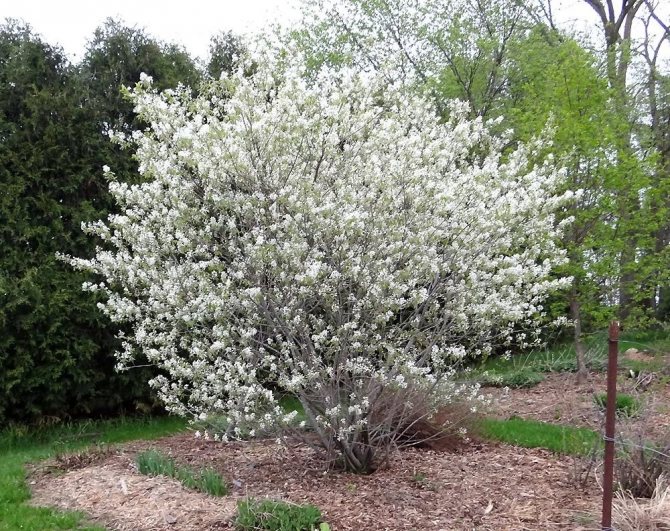

Sturgeon is a more compact shrub with high yields.
Unique differences:
• rarely grows more than 3 m;
• berries are large and sweet, there is no astringency;
• the variety has a stable yield.
Sturgeon can be planted as a hedge. A decoction of leaves and berry juice raise immunity, help to cope with many diseases.
Northline
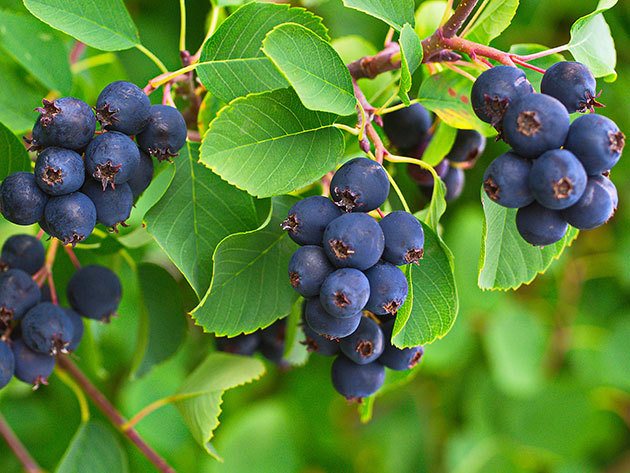

Northline grows 3-4 m up. The berries are large-fruited, ripen amicably and tolerate transportation well. Up to 10-12 kg of harvest is removed from one plant, which ripens by the beginning of summer. The fruits are distinguished by a bright aroma.
Planting and caring for the Canadian Irga
Planting a non-capricious Canadian Irga is a standard procedure. Any planting period, depending on the climate of the region. In the south and in the middle lane, they are planted in the fall, until November. In areas with early frost, it will be most appropriate to plant Canadian Irga in the spring.
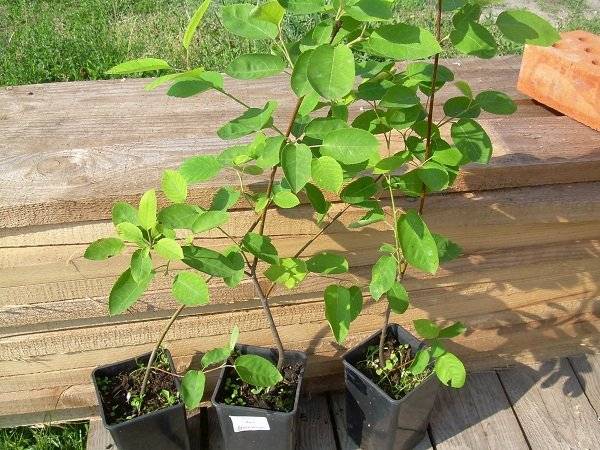

Site selection and preparation
Irga of fruit varieties grows on all types of soils, in shady places, it does not care for cold winds, but it is necessary to avoid swampy areas. Bushes can be planted from the north of the site both as a fruit crop and as a hedge. If an irgi is grown for picking berries, the holes are placed at a distance of 4-5 m. For pollinators, sea buckthorn, rose hips, and other varieties of irgi are selected. Although the varieties are mostly self-fertile, the yield will increase.
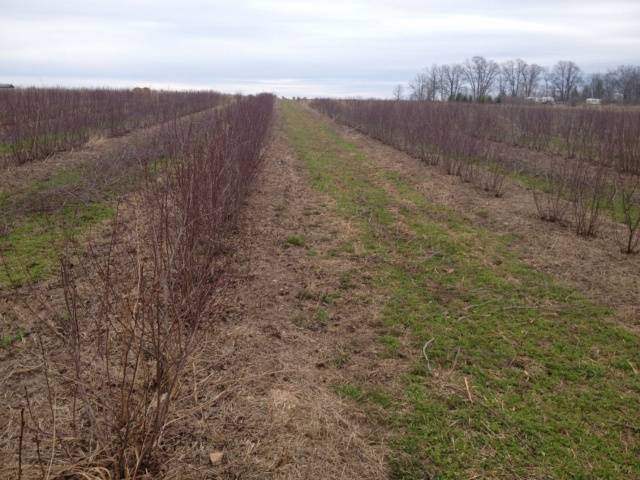

How to choose seedlings
When buying an irgi seedling not in a container, make sure that the roots are fibrous, fresh, not shorter than 20 cm.The stem is without scratches, outgrowths, with smooth bark and swollen buds, at least 80-100 cm high. The best ones are 1-2 years old seedlings.
Landing
The soil should be loose, preferably neutral. Do not oversaturate the soil, Irga prefers ordinary garden soil in combination with humus. Groundwater should be located at a distance of at least 2 m from the root system.
Important!
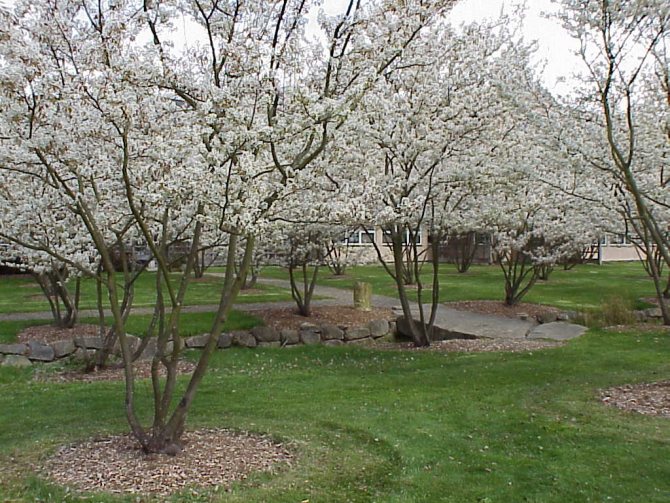

If it is planned to grow a shrub from Irga, the root collar is deepened by 1.5-2 cm. If Irga is to grow into a tree, the root collar is left above the ground.
Step-by-step instruction:
1. A recess is dug with a depth of 50 cm, a width of 55-60 cm.
2. The soil is prepared from a mixture of garden soil, 2 buckets of humus and 500 g of superphosphate.
3. Drainage is laid out at the bottom. Sprinkled with a small amount of soil.
4. A seedling is installed, the roots are straightened and covered with earth.
5. The soil is compacted along the near-trunk circle so that the plant is well kept in the ground.
6. A young seedling is abundantly watered with 15 liters of settled water.
7. On the near-trunk circle, mulch from humus is laid out. It will prevent weeds and keep moisture in the ground.
Growing conditions
We will find out what conditions must be provided for the Canadian Irga so that it annually pleases with magnificent harvests.
The Canadian Irga also does not impose special requirements on the site. The relief of the site can be of any kind - irga is capable of growing both on the hills and in the lowlands.
The plant is also calm about the close occurrence of groundwater. As a rule, other fruit crops grow poorly in such places, so the low-lying areas of the garden can be used by planting an unpretentious irga.
You can plant this shrub on the northern side of the site - where many other garden crops refuse to grow. Not far from the irga, it is good to plant shorter and more delicate fruit bushes - raspberries, gooseberries, currants - the irga will become a real protection for smaller plants.
Although the irga can grow and produce crops in a shaded area of the garden, it is still better to choose a well-lit place for it. This will guarantee the successful development of the plant, the absence of putrefactive and fungal diseases, and a good harvest. Note that, growing in the shade, irga gives a much lower yield and is more likely to get sick.
This plant is undemanding to the composition of the soil, capable of bearing fruit, even growing in poor soil. However, in infertile soil, the roots of irgi grow strongly, even come out to the surface. Therefore, in order to avoid this, it is better to initially fertilize the garden bed for planting a plant. Recommended soil mixture:
- sod / garden land - 2 parts;
- peat - 1 part;
- sand - 1 part.
The acidity of the soil in this case does not matter.
We will learn how to properly plant a Canadian Irga in your garden.
Timing
The best time to root this plant is autumn or early spring. Most choose autumn, since during this period there is a large selection of high-quality planting material.
Pit preparation
For autumn planting, the pit is prepared in spring, and for spring planting - from autumn. A recess with dimensions of 60x50 cm is dug. The area surrounding the pit must be freed from weeds, dug up.
At the bottom of the pit, a layer of potassium-phosphate fertilizers, humus and lime is laid. The last component is added only if the soil is highly acidic. All fertilizers are mixed with the ground and placed in the pit. In this form, a place for planting is left - and by the time of rooting, the soil will become sufficiently nutritious.
Landing procedure
- In the center of the pit, a small elevation is made from a mixture of soil and fertilizers.
- The seedling is placed vertically on a formed earthen mound.
- The roots of the plant are spread along the "slopes" of the hill.
- Cover the plant with soil, tamping the soil in the process.
- After planting, the seedling is watered with one or two buckets of water.
- The root circle is mulched so that the water moisturizes the roots longer. It is recommended to use natural materials, organic matter as mulch: peat, dry soil, humus.
- Immediately after planting, the seedling is cut off by a third of the height, leaving no more than five full-fledged, developed buds on it.
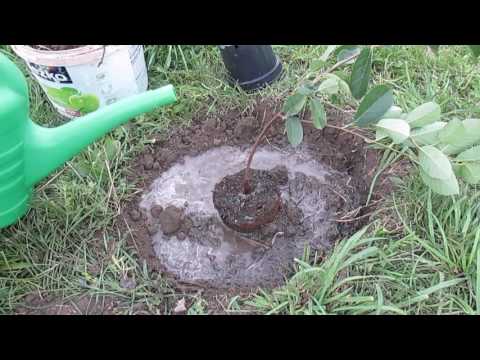

If several specimens of irgi are planted, the distance between them should be at least 2-3 meters - do not forget that an adult tree has a very wide, spreading crown. In the case when the canadensis is used as a hedge, it is necessary to plant the plants in a checkerboard pattern.
The plant is undemanding to care. The Canadian Irga endures severe frosts without shelter, is able to resist drought, winds, and other natural phenomena. We will find out what points you should still pay attention to when growing this crop.
Due to the fact that when planting a sufficient amount of nutrients is introduced into the pit, they begin to feed the irga from the third year after rooting.
In the spring, nitrogen-containing fertilizers are applied to the soil to create lush greenery. And in summer, irgu is fed with potassium and phosphorus - for more ovaries and larger berries. The plant also needs organic matter: you can add manure, chicken droppings, rotten sawdust, tree bark, green manure silage.
Most often, irga is formed in the form of a shrub with several trunks.For this, in the first years after planting, all weak underdeveloped shoots are cut off, and a skeleton of 2-3 strong skeletal branches is gradually formed. An adult tree consists of 10-15 such skeletal branches, to which fruiting lateral shoots are already attached.
Read also: Caring for an apple tree in the fall after harvesting and preparing for winter: watering and feeding, processing trees
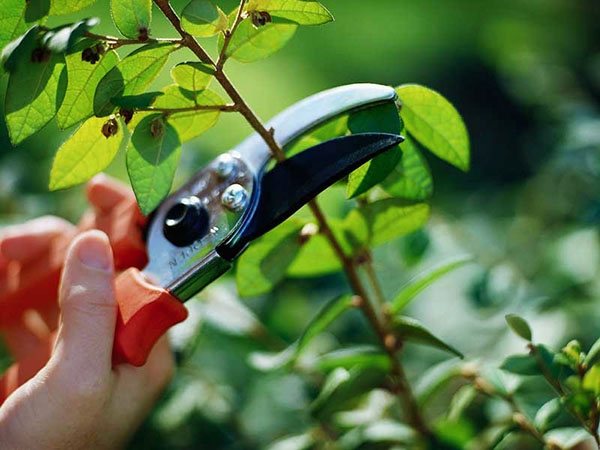

When the main part of the formative pruning is behind, rejuvenating pruning is started regularly. This procedure is aimed at getting rid of all weak, old and highly elongated shoots.
Important: after pruning, be sure to treat the cuts with garden pitch to protect the plant from infection.
Protection against diseases and pests
The plant is considered resistant to most diseases of fruit crops, as well as to pest attacks. However, in rare cases, the following parasites can be dangerous for irgi:
- currant leaf roll;
- rose leafworm (its caterpillars).
These insects devour the leaves of the irgi, as well as the young green tops of the shoots. To avoid this misfortune, when carrying out preventive spraying with insecticides, one should not forget about irga.
The danger in this case is also represented by birds, which really like the taste of the plant's juicy berries. Usually, to protect the crop from feathered irgi bushes, they are covered with a net.
Canadian Irga is a wonderful plant that bears delicious berries and is pleasing to the eye with its decorative look. It is quite simple to grow irgu - thanks to the unpretentiousness of the plant, a novice gardener will also cope with this.
Care
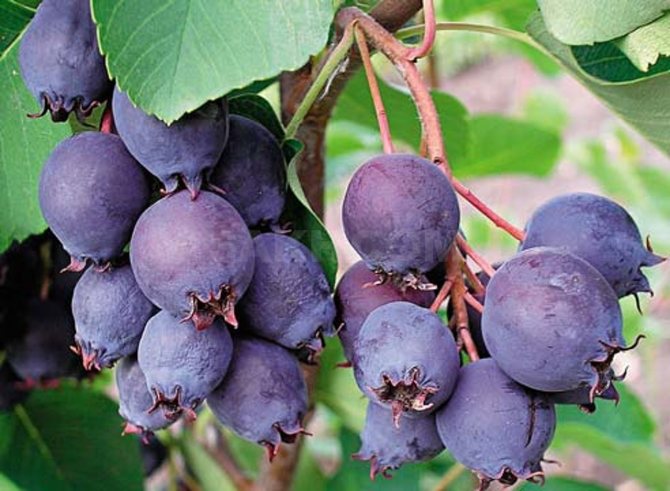

Irga usually suffers from migratory birds. She is rarely sick or attacked by insects. However, it is better to follow the rules of care so as not to provoke a fungal infection or the development of a pest colony.
Fertilizers and feeding
You can feed the shrub 2 years after planting. At this time, the soil, which has been generously fertilized with compost, is being depleted.
Fertilizers required by Irga:
1. In March-April, nitrogen fertilizing is added. They are introduced in a volume of 40-50 g along the near-trunk circle.
2. In the summer, add mullein, bird droppings, and cut grass as mulch.
3. Potash supplements are used in the first autumn months. Wood ash is also used.
4. During flowering, complex additives can be added.
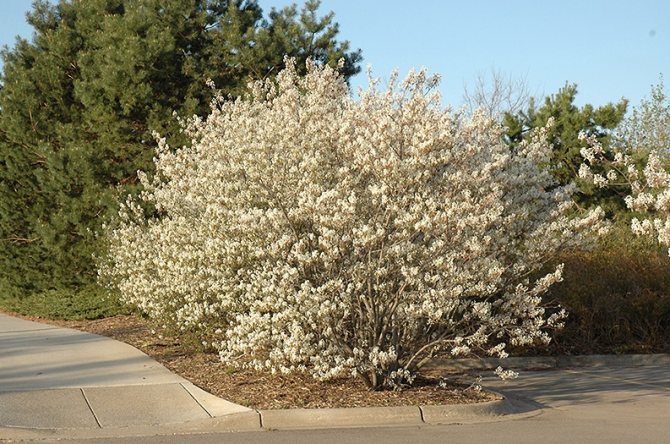

Watering
Abundant watering is required in the first 5 years of plant life. During the growth and formation of the crown, a lot of moisture is also required.
An adult shrub that is already bearing fruit is watered during drought and flowering. The rest of the time, hydration is not necessary.
Pruning
The shrub needs formative pruning at least once a year. Otherwise, it will lose its decorative appearance. Young shoots are cut off from annual growth. This is necessary to stimulate growth and form a neat crown.
At the 6th year of life, Irgu is subjected to crown thinning. This will help prevent fungal infections and shoot shading.
Root shoots are trimmed as they emerge. It takes away the strength of the plant, without benefit.
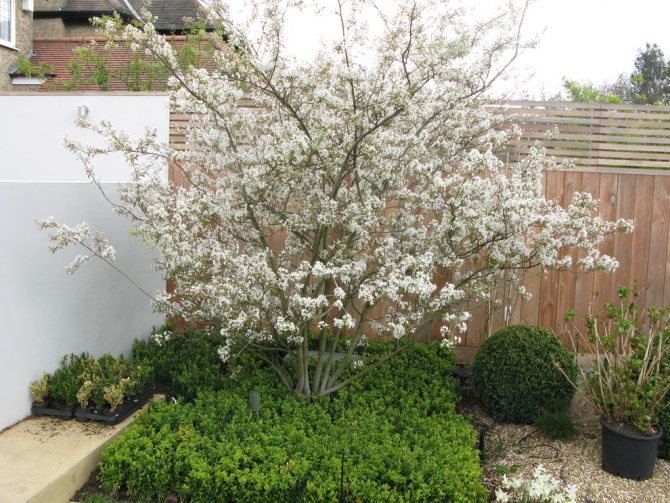

Pest and disease control measures
It is not difficult to grow Canadian irga in the country, because its main difference from other horticultural crops is that it is extremely rarely more and almost not affected by pests.
Diseases, in particular gray rot and leaf spot, can occur during prolonged rains, which provoke stagnation of moisture at the roots. As a rule, to combat these pathologies, it is enough to treat the plants with copper preparations.


Figure 7. Birds and fungal diseases cause the most harm to irge
Pests also rarely infect irgu. A certain danger to culture is posed not so much by insects as by birds, who really like irgi berries. To protect the crop, it is advisable to cover each bush with a fabric mesh with fine cells.
Diseases
Most of the diseases from which Irga suffers are fungal infections. If you follow all the rules for caring for the shrub and monitor the plants in the garden, the risk of developing diseases will be minimal.
Leaf spot
Spotting manifests itself in different ways, it depends on the fungus of the pathogen that has affected the shrub. The spots that begin to cover the plant can be of different colors and shapes.
To avoid spotting, preventive spraying with Bordeaux liquid is carried out every spring.
Treatment consists of fungicide treatments. Horus, Speed and Topaz will do.
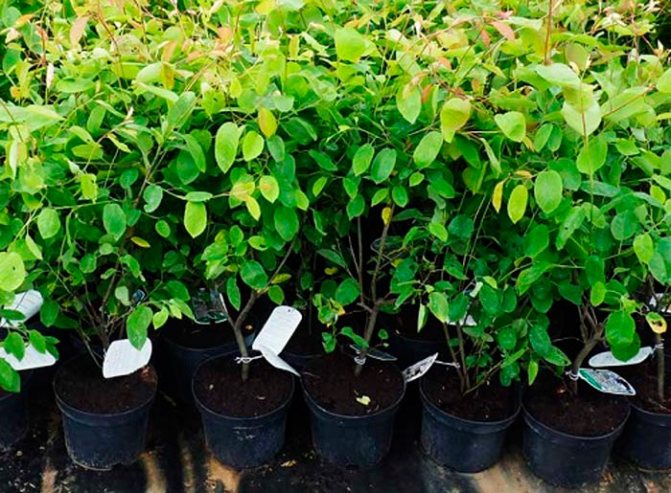

Moniliosis
The disease causes the shoots to dry out. Moniliosis usually appears after flowering. The infected parts of the shrub are cut and burned.
To prevent moniliosis, the plant is sprayed with copper sulfate. As a treatment, they are treated with Bordeaux liquid or fungicides.
Powdery mildew
Powdery mildew is a fungus. It looks like white spots, as if plaque is forming on the leaves. They grow rapidly and begin to cover all the foliage. As a result, the leaves begin to dry out, and then the weakened ones fall off.
For treatment, start treatment with drugs "Jet", "Raek" or "Skor".
Gray rot
The base of the branches and fruits begin to become covered with a kind of wet spots, which gradually turn into a gray bloom. Plaque, when examined, resembles mold, these are fungal spores. Gray mold can appear due to high humidity. To prevent the development of the disease, you need to observe the watering rate.
The plant is showered with wood ash, the same is done with the trunk circle. It is permissible to use colloidal sulfur.


Tuberculariosis
The symptom of the disease is red growths that spread along the shoots and foliage. The prevention of the disease is the appropriate care for the irga, as well as the mandatory cleaning of cut and fallen shoots, foliage, fruits.
To get rid of tuberculariosis, you first need to:
• cut off all damaged branches and foliage;
• all waste is burned so that the disease does not spread to neighboring plants and does not remain in the ground;
• then carry out the treatment with 1% Bordeaux liquid every 10 days, you can use copper sulphate;
• treatment continues until the tree is fully recovered.
Irga canadian: features of the species
Ornamental shrub - Canadian irga, depending on the variety, can grow from 2 to 7 meters in height. It is an upright crop with long, smooth shoots that droop slightly to form a wide oval crown. The young growth is slightly reddish in color, while the old branches are usually brownish in color.
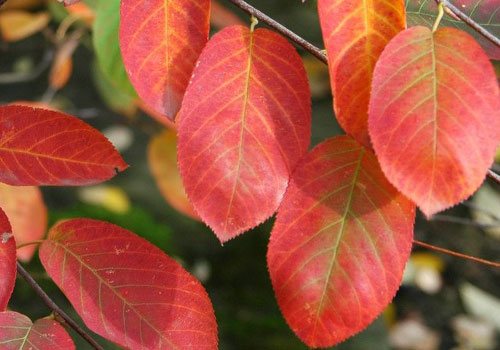

The leaves of the canadensis canadensis, ovoid in shape, grow up to 10 cm in length. They have an unusual color. When blooming in spring, they are brownish green. In the summer they acquire a bluish tide. And with the onset of autumn, they become crimson-golden. At this time, the shrub looks especially impressive. The leaves are soft to the touch, slightly rough, tucked up with a delicate downy.
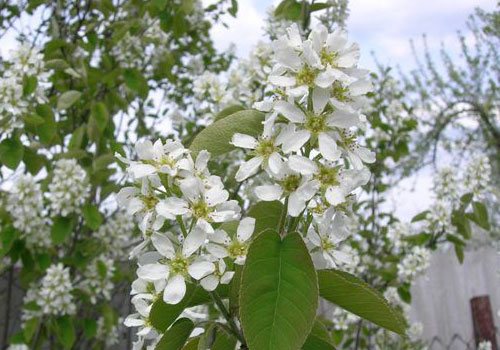

Irga canadensis blooms in late spring with large snow-white flowers. The buds do not last long, from a week to 10 days. Individual flowers are collected in drooping clusters of 5-12 pieces. They go especially well with reddish young shoots. Almost every flower forms an ovary, so the irga is one of the generously fruiting plants.
Irga canadensis produces fruits, excellent in taste and healing properties, reminiscent of wild rose berries in shape and size. They are rounded, as they ripen, they turn into light pink, and then dark blue with a purple tint. Ripe berries have a gray waxy coating. They are edible. Unlike other species of this culture, the fruits of the canadian irgi are sweeter than others, since they contain a large amount of sugar and very little acid. Birds adore them.Therefore, in order to keep the harvest intact, it is necessary to throw nets or other protection from birds over the bush.
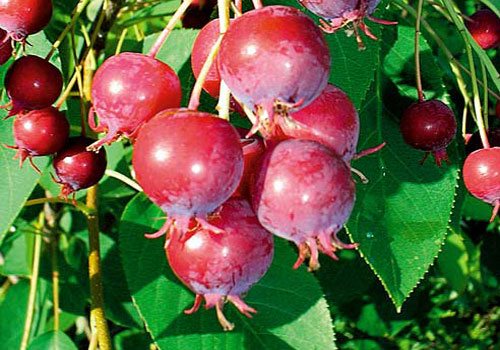

The berries of the plant look beautiful against the background of foliage all season. At first, these are pinkish beads, originally braiding the bush. Then deep blue drops sprayed over the branches. If birds do not peck them, then they persist until severe frosts, when the foliage will already fly around, and bare shoots will remain.
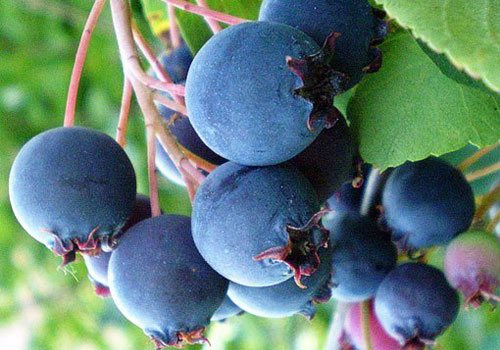

Irga Canadian is one of the best representatives of her family. It is distinguished by excellent frost resistance, unpretentious maintenance, undemanding to the composition of the soil. However, in order for the plant to bloom beautifully and luxuriantly and produce berries with excellent sugar content, it must be placed in an open area that is well lit during the day. Although, by planting a bush in the shade of other plants, over time, the gardener will observe that the irga will outgrow everyone and rise above its rivals. And it grows quickly, reaching its optimal size for 3-4 years.
To emphasize the decorative features of the canadian irgi, they are pruned and given a beautiful oval shape. From this, the plant becomes even better, young shoots with fruit buds are formed.

